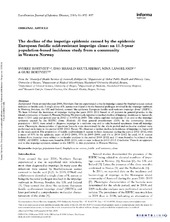| dc.contributor.author | Rørtveit, Sverre | en_US |
| dc.contributor.author | Skutlaberg, Dag Harald | en_US |
| dc.contributor.author | Langeland, Nina | en_US |
| dc.contributor.author | Rørtveit, Guri | en_US |
| dc.date.accessioned | 2014-12-30T11:54:20Z | |
| dc.date.available | 2014-12-30T11:54:20Z | |
| dc.date.issued | 2014-12 | eng |
| dc.identifier.issn | 0036-5548 | |
| dc.identifier.uri | https://hdl.handle.net/1956/9057 | |
| dc.description.abstract | Background: From around the year 2000, Northern Europe experienced a rise in impetigo caused by Staphylococcus aureus resistant to fusidic acid. A single clone of S. aureus was found to be the bacterial pathogen involved in the impetigo outbreak in Norway, Sweden, the UK and Ireland, termed ‘the epidemic European fusidic acid-resistant impetigo clone’ (EEFIC). We have followed the incidence of impetigo during the years 2001–2012 based on all patients in general practice in the island community of Austevoll, Western Norway. We previously reported a marked decline of impetigo incidence in Austevoll, from 0.0260 cases per person-year in 2002 to 0.0038 in 2009. This article explores indications of an end to the impetigo epidemic caused by the EEFIC clone. Methods: All four general practitioners (GPs) in the community (mean population = 4400) were asked to diagnose impetigo in a uniform way and to take bacterial specimens from all impetigo cases. Phenotypic characteristics of specimen bacteria were determined for the whole period and molecular analyses were performed on isolates in the period 2008–2012. Results: We observed a further decline in incidence of impetigo in Austevoll in the study period. The proportion of fusidic acid-resistant S. aureus isolates decreased during the period 2002–2012, with a mean of 80% in the epidemic years of 2002–2004, 55% in 2005–2009, and 6% in 2010–2012. In total, 44 S. aureus isolates from impetigo were subject to molecular analyses in the period 2008–2012, and 11 were found to be related to the EEFIC. All EEFIC isolates were found in 2008–2009, with no new isolates in 2010–2012. Conclusion: There is an apparent end to the impetigo epidemic related to the EEFIC in this population in Western Norway. | en_US |
| dc.language.iso | eng | eng |
| dc.publisher | Informa Healthcare | eng |
| dc.rights | Attribution-NonCommercial-NoDerivs CC BY-NC-ND | eng |
| dc.rights.uri | http://creativecommons.org/licenses/by-nc-nd/3.0/ | eng |
| dc.subject | Impetigo | eng |
| dc.subject | population-based | eng |
| dc.subject | Staphylococcus aureus | eng |
| dc.subject | fusidic acid resistance | eng |
| dc.subject | clone | eng |
| dc.title | The decline of the impetigo epidemic caused by the epidemic European fusidic acid-resistant impetigo clone: an 11.5-year population-based incidence study from a community in Western Norway | en_US |
| dc.type | Peer reviewed | |
| dc.type | Journal article | |
| dc.date.updated | 2014-12-30T11:49:03Z | |
| dc.description.version | publishedVersion | en_US |
| dc.rights.holder | Copyright 2014 Informa Healthcare | |
| dc.identifier.doi | https://doi.org/10.3109/00365548.2014.947317 | |
| dc.identifier.cristin | 1166167 | |
| dc.source.journal | Scandinavian Journal of Infectious Diseases | |
| dc.source.40 | 46 | |
| dc.source.14 | 12 | |
| dc.source.pagenumber | 832-837 | |

